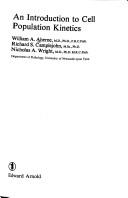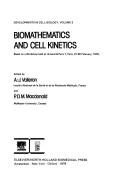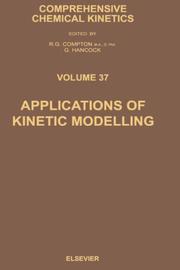| Listing 1 - 10 of 16 | << page >> |
Sort by
|
Book
ISBN: 0511529767 Year: 1996 Publisher: Cambridge : Cambridge University Press,
Abstract | Keywords | Export | Availability | Bookmark
 Loading...
Loading...Choose an application
- Reference Manager
- EndNote
- RefWorks (Direct export to RefWorks)
Cytokinesis is the division of the cell body that follows the sorting and transport of chromosomes. This book traces the history of some of the major ideas in the field and gives an account of our current knowledge of animal cytokinesis. It contains descriptions of division in different kinds of cells and the proposed explanations of the mechanisms underlying the visible events. Experiments devised to test cell division theories are described and explained. The forces necessary for cytokinesis now appear to originate from the interaction of linear polymers and motor molecules that have roles in force production, motion and shape change that occur in other phases of the biology of the cell. The localization of the force-producing division mechanism to a restricted linear part of the subsurface is caused by the mitotic apparatus, the same cytoskeletal structure that ensures orderly mitosis.
Book
ISBN: 0127812407 1299819389 0323148085 9780127812403 Year: 1981 Publisher: New York, NY : Academic Press,
Abstract | Keywords | Export | Availability | Bookmark
 Loading...
Loading...Choose an application
- Reference Manager
- EndNote
- RefWorks (Direct export to RefWorks)
Mitosis --- Cytokinesis --- Cell Cycle.
Book
Abstract | Keywords | Export | Availability | Bookmark
 Loading...
Loading...Choose an application
- Reference Manager
- EndNote
- RefWorks (Direct export to RefWorks)
Together with the microfilament, microtubule and intermediate-filament networks, septins constitute an integral part of the eukaryotic cytoskeleton. Historically identified as proteins critical for septum formation in the budding yeast Saccharomyces cerevisiae, septin family GTPases are expressed and participate in the process of cytokinesis in most eukaryotes except higher plants. More than a dozen septin genes in mammals, together with various splice variants displaying tissue-specific expression patterns and flexible hetero-polymeric higher-order assembly achieve an unfathomable complexity superior to the other cytoskeletal components. Even though the initial studies in the septin field was restricted to their evolutionarily conserved role in cell division, strong expression of septins in the non-dividing cells of the brain generated great interest in understanding their role in neuronal morphogenesis and other aspects of cellular function. On one hand, recent developments indicate complex non-canonical roles for septins in diverse processes ranging from neuronal development to immune response and calcium signaling. On the other hand several lines of data including those from knockout models question the universal role for septins in animal cell cytokinesis. Mammalian hematopoietic cells seem to proliferate and efficiently undergo cytokinesis in the absence of pivotal septin proteins in a context-dependent manner. The lack of septin-dependence of hematopoiesis also opens the possibility of safely targeting septin-dependent cytokinesis for solid-tumor therapy. Thus the septin field is perfectly poised with novel roles for septins being discovered and the basic understanding on septin assembly and its canonical functions constantly revisited. The objective of this research topic was to provide an exclusive platform for discussing these rapid advances in the septin field. With a mixture of reviews and research articles encompassing diverse areas of septin research, ranging from the humble yeast model to human cancer, this ebook will be an interesting reading material for both experts as well as new comers to the septin field.
mutation --- cytoskeleton --- cytokinesis --- budding --- SOCE --- septin --- cancer --- GTPase --- yeast --- Cilia
Book
Abstract | Keywords | Export | Availability | Bookmark
 Loading...
Loading...Choose an application
- Reference Manager
- EndNote
- RefWorks (Direct export to RefWorks)
Together with the microfilament, microtubule and intermediate-filament networks, septins constitute an integral part of the eukaryotic cytoskeleton. Historically identified as proteins critical for septum formation in the budding yeast Saccharomyces cerevisiae, septin family GTPases are expressed and participate in the process of cytokinesis in most eukaryotes except higher plants. More than a dozen septin genes in mammals, together with various splice variants displaying tissue-specific expression patterns and flexible hetero-polymeric higher-order assembly achieve an unfathomable complexity superior to the other cytoskeletal components. Even though the initial studies in the septin field was restricted to their evolutionarily conserved role in cell division, strong expression of septins in the non-dividing cells of the brain generated great interest in understanding their role in neuronal morphogenesis and other aspects of cellular function. On one hand, recent developments indicate complex non-canonical roles for septins in diverse processes ranging from neuronal development to immune response and calcium signaling. On the other hand several lines of data including those from knockout models question the universal role for septins in animal cell cytokinesis. Mammalian hematopoietic cells seem to proliferate and efficiently undergo cytokinesis in the absence of pivotal septin proteins in a context-dependent manner. The lack of septin-dependence of hematopoiesis also opens the possibility of safely targeting septin-dependent cytokinesis for solid-tumor therapy. Thus the septin field is perfectly poised with novel roles for septins being discovered and the basic understanding on septin assembly and its canonical functions constantly revisited. The objective of this research topic was to provide an exclusive platform for discussing these rapid advances in the septin field. With a mixture of reviews and research articles encompassing diverse areas of septin research, ranging from the humble yeast model to human cancer, this ebook will be an interesting reading material for both experts as well as new comers to the septin field.
mutation --- cytoskeleton --- cytokinesis --- budding --- SOCE --- septin --- cancer --- GTPase --- yeast --- Cilia
Book
Abstract | Keywords | Export | Availability | Bookmark
 Loading...
Loading...Choose an application
- Reference Manager
- EndNote
- RefWorks (Direct export to RefWorks)
Together with the microfilament, microtubule and intermediate-filament networks, septins constitute an integral part of the eukaryotic cytoskeleton. Historically identified as proteins critical for septum formation in the budding yeast Saccharomyces cerevisiae, septin family GTPases are expressed and participate in the process of cytokinesis in most eukaryotes except higher plants. More than a dozen septin genes in mammals, together with various splice variants displaying tissue-specific expression patterns and flexible hetero-polymeric higher-order assembly achieve an unfathomable complexity superior to the other cytoskeletal components. Even though the initial studies in the septin field was restricted to their evolutionarily conserved role in cell division, strong expression of septins in the non-dividing cells of the brain generated great interest in understanding their role in neuronal morphogenesis and other aspects of cellular function. On one hand, recent developments indicate complex non-canonical roles for septins in diverse processes ranging from neuronal development to immune response and calcium signaling. On the other hand several lines of data including those from knockout models question the universal role for septins in animal cell cytokinesis. Mammalian hematopoietic cells seem to proliferate and efficiently undergo cytokinesis in the absence of pivotal septin proteins in a context-dependent manner. The lack of septin-dependence of hematopoiesis also opens the possibility of safely targeting septin-dependent cytokinesis for solid-tumor therapy. Thus the septin field is perfectly poised with novel roles for septins being discovered and the basic understanding on septin assembly and its canonical functions constantly revisited. The objective of this research topic was to provide an exclusive platform for discussing these rapid advances in the septin field. With a mixture of reviews and research articles encompassing diverse areas of septin research, ranging from the humble yeast model to human cancer, this ebook will be an interesting reading material for both experts as well as new comers to the septin field.
mutation --- cytoskeleton --- cytokinesis --- budding --- SOCE --- septin --- cancer --- GTPase --- yeast --- Cilia --- mutation --- cytoskeleton --- cytokinesis --- budding --- SOCE --- septin --- cancer --- GTPase --- yeast --- Cilia
Book
ISBN: 9782804159474 2804159477 Year: 2007 Publisher: Bruxelles Paris : De Boeck,
Abstract | Keywords | Export | Availability | Bookmark
 Loading...
Loading...Choose an application
- Reference Manager
- EndNote
- RefWorks (Direct export to RefWorks)
Cell cycle. --- Cytokinesis. --- Division of cells --- Cell proliferation --- Mitotic cycle --- Nuclear cycle (Cytology) --- Cell division. --- Cell division --- Cytoplasm --- Biological rhythms --- Cell cycle --- Cytokinesis

ISBN: 0897665996 0897666003 Year: 1990 Volume: 582 Publisher: New York, NY : New York Academy of Sciences,
Abstract | Keywords | Export | Availability | Bookmark
 Loading...
Loading...Choose an application
- Reference Manager
- EndNote
- RefWorks (Direct export to RefWorks)
Cytokinesis --- CELL DIVISION, physiology --- Congresses. --- Cell division, physiology --- Congresses --- Cell Division. --- Cell Division

ISBN: 0713142944 9780713142945 Year: 1977 Publisher: London Arnold
Abstract | Keywords | Export | Availability | Bookmark
 Loading...
Loading...Choose an application
- Reference Manager
- EndNote
- RefWorks (Direct export to RefWorks)
Histology. Cytology --- Cell populations --- Cytokinesis --- Cell Division. --- Kinetics. --- Cell division --- Cytoplasm --- Cell Division Phase --- Cell Divisions --- M Phase --- Division Phase, Cell --- Division, Cell --- Divisions, Cell --- M Phases --- Phase, Cell Division --- Phase, M --- Phases, M --- Cleavage Stage, Ovum --- Cell populations. --- Cytokinesis. --- Kinetics --- Cell division. --- Cell Division --- Populations, Cell --- Cell proliferation --- Cytology --- Genetics

ISBN: 044480059X 9780444800596 Year: 1978 Volume: 2 Publisher: Amsterdam Elsevier/North-Holland
Abstract | Keywords | Export | Availability | Bookmark
 Loading...
Loading...Choose an application
- Reference Manager
- EndNote
- RefWorks (Direct export to RefWorks)
Cytokinesis --- Cell Biology --- Kinetics --- Models, Biological --- Mathematics --- Mathematical models --- Congresses --- Cell Biology. --- Kinetics. --- Mathematics. --- Models, Biological. --- -Cell division --- Cytoplasm --- Biological Model --- Biological Models --- Model, Biological --- Models, Biologic --- Biologic Model --- Biologic Models --- Model, Biologic --- Mathematic --- Cellular Biology --- Cytology --- Biologies, Cell --- Biologies, Cellular --- Biology, Cell --- Biology, Cellular --- Cell Biologies --- Cellular Biologies --- -Congresses --- -Mathematical models --- Cell division --- Mathematical models&delete& --- Cytokinesis - Mathematical models - Congresses --- Cell Biology - congresses --- Kinetics - congresses --- Models, Biological - congresses --- Mathematics - congresses

ISBN: 9780444501646 0444501649 9780080527345 0080527345 9786611054588 1281054585 Year: 1999 Publisher: Amsterdam ; New York : Elsevier,
Abstract | Keywords | Export | Availability | Bookmark
 Loading...
Loading...Choose an application
- Reference Manager
- EndNote
- RefWorks (Direct export to RefWorks)
Volume 37 is concerned with the use and role of modelling in chemical kinetics and seeks to show the interplay of theory or simulation with experiment in a diversity of physico-chemical areas in which kinetics measurements provide significant physical insight. Areas of application covered within the volume include electro- and interfacial chemistry, physiology, biochemistry, solid state chemistry and chemical engineering. A leading contributor to this general area has been Professor W. John Albery, FRS, to whom the contributors and editors dedicate this book.
Cytokinesis --- Mathematical models --- Chemical kinetics --- Reactivity (Chemistry) --- Chemical reaction, Conditions and laws of --- Chemical reactions --- Chemical reaction, Kinetics of --- Chemical reaction, Rate of --- Chemical reaction, Velocity of --- Chemical reaction rate --- Chemical reaction velocity --- Kinetics, Chemical --- Rate of chemical reaction --- Reaction rate (Chemistry) --- Velocity of chemical reaction --- Chemical affinity --- Mathematical models.
| Listing 1 - 10 of 16 | << page >> |
Sort by
|

 Search
Search Feedback
Feedback About UniCat
About UniCat  Help
Help News
News